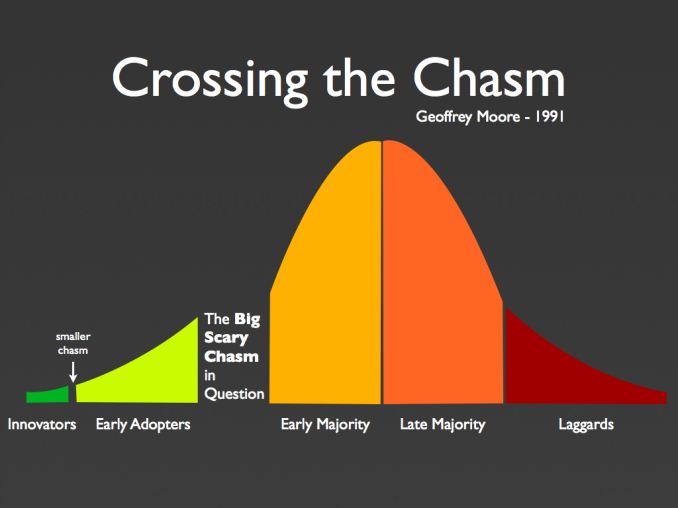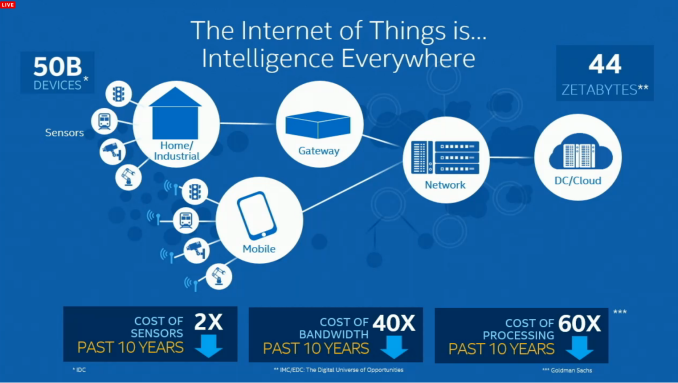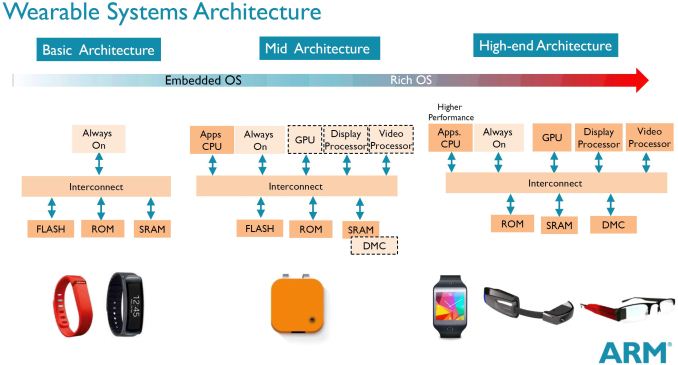Wearables: 2014 and Beyond
by Stephen Barrett on January 15, 2015 11:50 AM EST- Posted in
- Wearables
- Apple
- Microsoft
- pebble
- Android Wear
- Microsoft Band
- Fitbit

As the year 2014 has come to a close, now is a good time to inventory changes in the consumer electronics market and project those trends forward. One of the most obvious changes was that wearable technology has, by my observation, approached the brink of the adoption chasm into the early majority. In this article we will focus on the significant business and consumer factors of wearable technology, the notable introductions in 2014, as well as future AnandTech coverage.
If you are unfamiliar with ‘the chasm’, this is a reference to an acclaimed technology marketing book by Geoffrey A. Moore in 1991. As seen in the figure below, Geoffrey describes five stages of adoption.
The first, consumers described as innovators, are on the very bleeding edge. Innovators have a combination of unique interest in the subject area and abundant disposable income. There is a small chasm between this group and the next. This small chasm has killed many technologies and you could probably argue that 3D TVs died here. Next, early adopters are more like typical AnandTech readers. These consumers are technologically savvy and often the technology go-to person for groups of family and friends. Early adopters are likely to have made investments into products that their friends have yet to invest in themselves. My wife described me this way when I made the jump from iPhone to Windows Phone. It was an early product without majority adoption (and still is), but I wanted it anyway.
This brings us to The Big Scary Chasm in Question. How does a technology explode from a “hobby”, as famously Apple described its Apple TV, to a staple like the iPhone? In the information age of today, crossing this chasm is primarily a focus of marketing. Sure, you need good product, but without effective marketing there is little chance of wide adoption. There are plenty examples of products that have been favorably reviewed by AnandTech and others but didn't see widespread adoption. Often, it's a case of competing against the marketing budget of a much larger company, but that's a topic for another day. In short, going from a cult hit to a market leader is difficult; hence, the Chasm.
Taking this back to wearables, 2014 saw the most marketing of wearables yet, and for good reason. The traditionally explosive smartphone and tablet markets are slowing down. Analysts at CCS Insight projected a fall of smartphone sales' yearly growth from 40% in 2013 to 25% in 2014 and 15% in 2015. Analysts at Gartner project a fall of tablet sales' yearly growth from 55% in 2013 to 11% in 2014. IDC projects 2014 tablet growth even worse at 7%. At the same time, wearable revenue is projected to dramatically grow. ABI Research projects wearable technology at a compound annual growth rate (CAGR) of 56.1% over the next five years. Finally, Price Waterhouse Coopers’ interview samples show that 76% of consumers do not need a new wearable device to replace functionality of an existing device.
The top consumer eco system players – Apple, Microsoft, Google, and Google’s partners – are growth companies. Continually increasing revenue is a corporate foundation. Without revenue growth, careers stagnate as no promotions or raises are possible. Go long enough without growth and your top talent can leave for a company with growth opportunity. In Samsung’s recent 3rd Quarter financial results, their revenue fell 20% year over year and Samsung primarily attributed this to smartphone struggles.
With all this data combined, it is a no-brainer for these consumer companies to shift resources to wearables. Therefore, all have made significant wearable announcements. Google’s partners and Microsoft have launched devices while Apple is alone in the laggard position of having nothing on the market (with Apple Watch coming this year).
Wearables: What Are They?
At their core, wearables are of course technological devices that you wear. In some sense, your smartphone is actually a wearable. Even though a smartphone usually does not directly contact your body, it is a wearable just as much as a smart purse or backpack is a wearable. However, as smartphones are already a category of their own, they are traditionally excluded even though the core technology is vastly similar. That core technology consists of sensors, wireless, storage and computing. Intel’s recent IoT (Internet of Things) platform launch contained a slide detailing the cost reduction of some of these components, which is an enabling factor of wearable growth.
Where wearables differ from smartphones is their function. By breaking from the traditional smartphone form factor a wearable can provide different benefits. These benefits can be broken down into different categories that closely mirror the contents of the device as different sensors, processors, wireless, and storage enable different use cases.
On the left side of the above diagram from ARM are devices that contain wireless connectivity, sensors, a low power microcontroller such as Coretex-M, small amounts of memory and storage; run an embedded OS; and potentially have an optional display. The vast majority of these devices today are for fitness and health, however some provide smart watch functionality as well. On the middle and right side of the diagram are devices that integrate higher end processing and storage such as full-blown application processors (think Cortex-A series) and DDR memory. These allow running richer, non-embedded operating systems (such as Android) and higher-end features at the cost of power consumption.













79 Comments
View All Comments
phoenix_rizzen - Thursday, January 15, 2015 - link
I wear a watch on a daily basis, and actually feel kind of naked without it. In fact, I almost can't tell time when I forget my watch, even though I have a phone in my pocket or hand at all times ... I still look at my wrist first and usually just go "ah crap" without checking my phone.I wear my watch on the bottom of my wrist (military style, or European style, or upside down, whatever you want to call it), which makes it very convenient to check the time while driving, or walking, or while holding things (like books). Much more convenient than trying to find my phone, or to stare down at the centre console in the car or to find a clock somewhere.
Now, that being said, I don't see a purpose to most of the smartwatches and fitness bands out there. I tend to not move my arms while walking, usually because they're holding my phone or a book, so I don't have much faith in "step counters" that don't attach to the parts that are "stepping". Most are also calibrated for the top of the wrist when it comes to heart rate monitoring, and I've yet to see a review that tested them on the bottom of the wrist. I also turn down my notifications (actually turn off cell/wifi radios via JuiceDefender) on the phone to only check every 30 minutes so not taking my phone out every 30 seconds isn't an issue.
name99 - Thursday, January 15, 2015 - link
"My one thought running through every page is who still wears a watch?"WOW. That is an original observation. I have never once, in the past three years, heard anyone make this claim before...
So you don't want to wear a watch? Fine, the party will move on without you and you won't be missed.
But what exactly do you expect an article on WEARABLES to talk about when the only damn wearable form factor that has any traction today is the watch/band? We're discussing here the wearables that one can buy today or, at least, in the next three months, not fantasies of what may be available in five years.
III-V - Thursday, January 15, 2015 - link
I wear one as a fashion accessory. Or I did, prior to the battery dying and the watch back needing enough pressure to compress graphite into a diamond to be put back on. Contrary to popular belief, how you look does matter.JohnnyBoBells - Friday, January 16, 2015 - link
Lots of people. We may not use it to tell time, but it is a great fashion accessory, especially for men, who are typically limited (albeit, by social standards, but that's a separate issue) in their options for wearable accessories. I've used my collection of watches as a great conversation starter (it's usually them who initiate, too!) with the numerous women I've bedded. A nice watch can complete that look along with a greatly tailored suit. So again, while maybe not used as often these days for its original intended purpose, watches are still worn by many people.aggiechase37 - Monday, January 19, 2015 - link
With the numerous women you've bedded? Remind me of the country song, so much cooler online.marvdmartian - Friday, January 16, 2015 - link
I've worn a watch since I was ~7 years old, and still do to this day. But being toward the end of the "baby boomer" generations, it's probably much more prevalent in mine, than in following generations.Phones/smartphones are okay for some functions, but I still find it much easier to just glance at my wrist to tell the time, than to pull out the phone. After 4+ decades of wearing a watch, it's unlikely I'd go without one, as it wouldn't feel natural.
eldakka - Thursday, January 22, 2015 - link
I stoped wearing watches because there was no need to wear a timekeeping/alarm device when the phone could do all this better and have many more functions. Now I feel naked without my smartwatch (like I used to feel before when I forgot my watch prior to smartphones) because with the watch I have the convienience of not having to retrieve a phone from my pockert to tell the time. I also no longer have to get the phone out to see whos calling to see if I care enough to fish it out to answer. I can see whis sent me aa sms and read the sms, and even send back pre-canned replies (useful for common replies such as "otw", "5 minutes out", "yes yes I wont forget to get it ") without getting out the phone.And im less likely to miss a call/sms/alarm/reminder with the wrist vibration (get your mind out of the gutter, yes I mean you!) when in noisy environments such as night clubs, train stations etc.
Dribble - Thursday, January 15, 2015 - link
Your use cases aren't great, you either have:a) fitness fanatics who love technology. I know plenty of people who stay fit and none of them need some device to tell them how they are doing. They kind of know as they live in the body in question. It's a market but its not very big.
b) people who can't be bothered taking their smart phone out of their pocket, which is all those watches enable - a short cut to see something your smart phone could show you.
The watch case make a little sense, if the watch was cheap enough (i.e. very cheap), but the whole point of wearables from a manufacturers point of view is their are something new that they can completely overcharge for.
The only one that really makes sense is google glass, but everyone has gone all 17 century on that and decided it's the work of the devil and all users need to be burned.
Penti - Thursday, January 15, 2015 - link
Obviously it would have to be a fashion accessory as once the watch was (and still is for some) to make sense spending millions into developing and marketing these devices. I wouldn't really use one if it doesn't have a semi-independent system running it's own apps, having it's own gps-receiver and so on. Though I have no use of having a cellular modem/radio in every device. Plus I don't wear jewelry so I don't see point of spending hundreds of dollars on one.For working out you don't really need to spend money, sure I was into mountain biking once but you don't need to spend hundreds of dollars on a cycle computer, you didn't need to about 20 years ago. Most people don't really need to collect those stats any way like these devices enable. Some other gear might cost you quite a lot though. But no need to really spend it on accessories. If you want to monitor your heart rate you don't need to spend more than a tens of dollars. If you want gps there is still a lot cheaper devices then say fitbit. Giving value to these devices will get tougher. Though I do see why companies like TomTom want to be in the game.
Stephen Barrett - Thursday, January 15, 2015 - link
Sure you dont need to do it but it does have benefits. For example Strava has an excellent fatigue graph it collects over time. Before a big race, you can adjust your prep accordingly to reduce your fatigue.